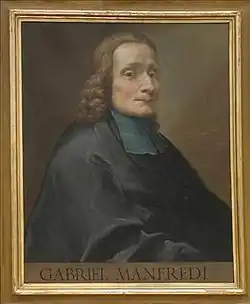Gabriele Manfredi
Gabriele Manfredi | |
|---|---|
 | |
| Born | 25 March 1681 |
| Died | 13 October 1761 (aged 80) |
| Resting place | Santa Maria Maddalena, Bologna |
| Nationality | Bolognese |
| Occupation | Mathematician |
| Employer | University of Bologna |
| Known for | Theory of first-order differential equations |
| Academic background | |
| Alma mater | University of Bologna |
| Academic work | |
| Notable students | Francesco Maria Zanotti |
| Notes | |
He is the brother of Eustachio Manfredi. | |
Gabriele Manfredi (25 March 1681 – 13 October 1761) was an Italian mathematician who worked in the field of calculus.
Early years
Gabriele Manfredi was born in Bologna, then in the Papal States, on 25 March 1681. He was the son of Alfonso Manfredi, a notary from Lugo, Emilia-Romagna, and Anna Maria Fiorini. His elder brother Eustachio studied law, then turned to science. Gabriele and his brother Eraclito studied medicine, while his fourth brother Emilio became a Jesuit preacher. His two sisters Maddalena and Teresa were also well educated, and later collaborated with their brothers in their work. Gabriele became uncomfortable with the study of anatomy, and turned to other subjects before he and Eustachio were introduced to the new subject of differential calculus by the physicist Domenico Guglielmini.[1]
Mathematician

Manfredi was one of a group of young men at the University who became interested in the techniques of Cartesian geometry and differential calculus, and who engaged in experiments and astronomical observation. Others were his brother Eustachio, Vittorio Francesco Stancari and Giuseppe Verzaglia. Of these, Gabriele Manfredi developed the most advanced understanding of mathematics.[2] Eustachio Manfredi became more interested in astronomy, but Gabriele persisted with mathematics, studying the works of Leibniz and of Johann and Jacob Bernoulli on infinitesimal calculus.[3]
After graduating, Gabriele went to Rome at the end of 1702, where he became librarian to Cardinal Pietro Ottoboni, a historian, antiquarian and astronomer. He helped Ottoboni build a sundial at Santa Maria degli Angeli e dei Martiri and helped in the work of reforming the Gregorian calendar. He continued to study mathematics, including differential and integral calculus and logarithmic curves. In 1707 he returned to Bologna where he published his best known work on first-order differential equations.[3] This was the first European work on differential equations. The book, praised by Leibniz and Johann Bernoulli and favourably reviewed by the Acta Eruditorum, quickly gained a great reputation throughout Europe.[3] It was regarded as the equivalent in the subject of the integral calculus to Guillaume de l'Hôpital’s Analyse des infiniment petits pour l'intelligence des lignes courbes (1696) in the subject of the differential calculus.[4] Despite this, Manfredi was not given a senior position in the university.[2] He made further contributions to the theory of calculus, although his main contribution after 1715 was as a teacher.[3]
Later career
In 1708 Manfredi began working for the Chancellery of the Senate of Bologna, where he rose to the rank of first chancellor and remained until he retired in 1752. From 1720 he also taught at the University of Bologna. In 1742 he was made superintendent of water, replacing his brother Eustachio. This job, concerned with improving river navigation while avoiding flooding, proved to be difficult and politically controversial.[3]
Manfredi married Teresa Del Sole, from the family of the painter Giovanni Gioseffo, and they had three children. He died in Bologna on 5 October 1761 at the age of 80, and was buried in the church of Santa Maria Maddalena, Bologna.[3] The asteroid 13225 Manfredi was named in honor of him and his two brothers, Eustachio and Eraclito.[5]
Work
In his work De constructionae aequationum differentialium primi gradu (1707) Manfredi set forth the results he had obtained so far in solving problems related to differential equations and the foundations of calculus. His paper Breve schediasma geometrico per la costruzione di una gran parte delle equazioni differenziali di primo grado (1714) described the procedure commonly adopted for integrating first-order homogeneous differential equations.[6]
List of works
- Manfredi, Gabriello (1707). De constructione aequationum differentialium primi gradus (in Latin). Bononiae: typis Constantini Pisarii. Retrieved 13 June 2015.
- Manfredi, Gabriello. Voto del sig. dottore Gabriello Manfredi pubblico professore di matematica nella Universita di Bologna sopra il parere de' due periti di Bologna e di Ravenna circa l'arginare il Po di Primaro da essi steso dopo la visita dello stesso Po fatta nel 1758. d'ordine della san. me. di Benedetto 14. [Bologna].
References
Citations
- ^ O'Connor & Robertson.
- ^ a b Feingold & Brotons 2006, p. 133.
- ^ a b c d e f Pepe 2007.
- ^ Tournès 2012, p. 261.
- ^ Gualandi & Bonoli 2004.
- ^ Gabriele Manfredi – MURST.
Sources
- O'Connor, John J.; Robertson, Edmund F., "Gabriele Manfredi", MacTutor History of Mathematics Archive, University of St Andrews
- Feingold, Mordechai; Brotons, Víctor Navarro (1 January 2006). Universities And Science in the Early Modern Period. Springer. ISBN 978-1-4020-3975-1. Retrieved 21 January 2013.
- "Gabriele Manfredi". Mille Anni di Scienza in Italia. Ministero dell'Università e della Ricerca Scientifica e Tecnologica. Retrieved 2013-01-22.
- Gualandi, Andrea; Bonoli, Fabrizio (2004). "Eustachio Manfredi e la prima conferma osservativa della teoria dell'aberrazione annua della luce" (PDF). Dipartimento di Astronomia, Università degli Studi di Bologna. Archived from the original (PDF) on 2014-11-03. Retrieved 2013-01-21.
- Roero, Clara Silvia (2004). "Gabriele Manfredi's treatise De constructione aequationum differentialium primi gradus (1707)". Oberwolfach Report. 51: 2734–2737.
- Pepe, Luigi (2007). "Manfredi, Gabriele". Dizionario Biografico degli Italiani, Volume 68: Malatacca–Mangelli (in Italian). Rome: Istituto dell'Enciclopedia Italiana. ISBN 978-88-12-00032-6. Retrieved 2013-01-22.
- Tournès, Dominique (2012). "Diagrams in the theory of differential equations (eighteenth to nineteenth centuries)". Synthese. 186 (1): 257–288. doi:10.1007/s11229-012-0069-z.